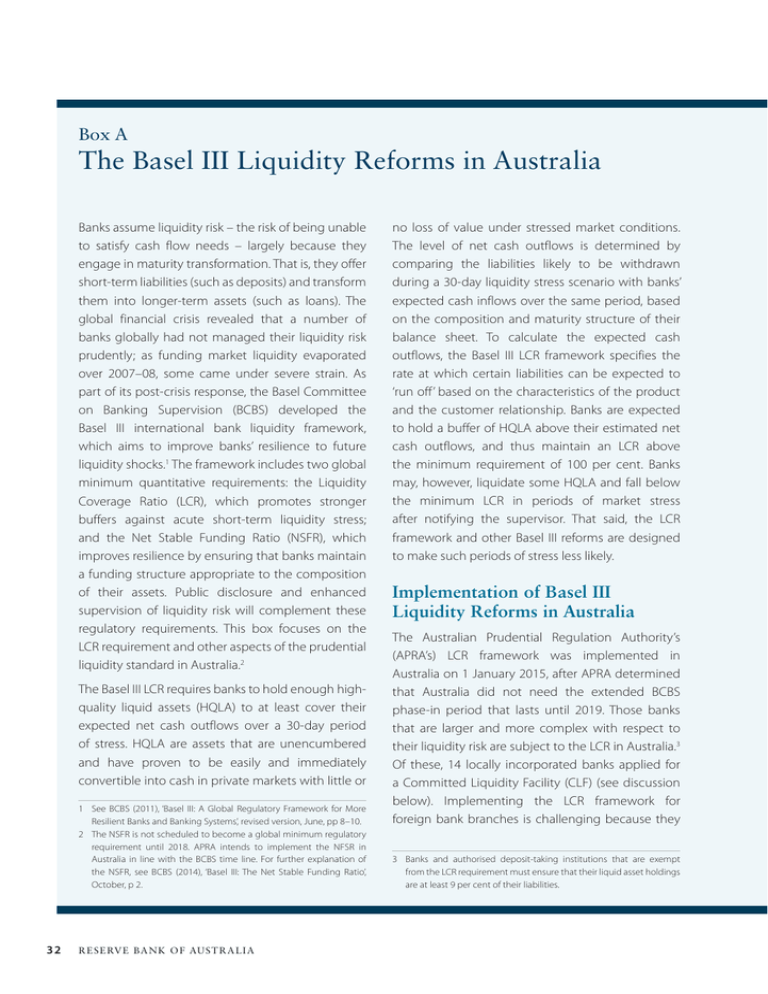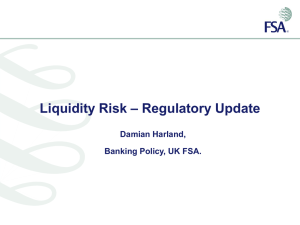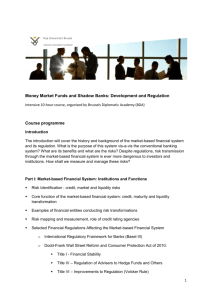The Basel III Liquidity Reforms in Australia Box A
advertisement

Box A The Basel III Liquidity Reforms in Australia Banks assume liquidity risk – the risk of being unable to satisfy cash flow needs – largely because they engage in maturity transformation. That is, they offer short-term liabilities (such as deposits) and transform them into longer-term assets (such as loans). The global financial crisis revealed that a number of banks globally had not managed their liquidity risk prudently; as funding market liquidity evaporated over 2007–08, some came under severe strain. As part of its post-crisis response, the Basel Committee on Banking Supervision (BCBS) developed the Basel III international bank liquidity framework, which aims to improve banks’ resilience to future liquidity shocks.1 The framework includes two global minimum quantitative requirements: the Liquidity Coverage Ratio (LCR), which promotes stronger buffers against acute short-term liquidity stress; and the Net Stable Funding Ratio (NSFR), which improves resilience by ensuring that banks maintain a funding structure appropriate to the composition of their assets. Public disclosure and enhanced supervision of liquidity risk will complement these regulatory requirements. This box focuses on the LCR requirement and other aspects of the prudential liquidity standard in Australia.2 The Basel III LCR requires banks to hold enough highquality liquid assets (HQLA) to at least cover their expected net cash outflows over a 30-day period of stress. HQLA are assets that are unencumbered and have proven to be easily and immediately convertible into cash in private markets with little or 1 See BCBS (2011), ‘Basel III: A Global Regulatory Framework for More Resilient Banks and Banking Systems’, revised version, June, pp 8–10. 2 The NSFR is not scheduled to become a global minimum regulatory requirement until 2018. APRA intends to implement the NFSR in Australia in line with the BCBS time line. For further explanation of the NSFR, see BCBS (2014), ‘Basel III: The Net Stable Funding Ratio’, October, p 2. 32 R ES ERV E BA NK OF AUS T RA L I A no loss of value under stressed market conditions. The level of net cash outflows is determined by comparing the liabilities likely to be withdrawn during a 30-day liquidity stress scenario with banks’ expected cash inflows over the same period, based on the composition and maturity structure of their balance sheet. To calculate the expected cash outflows, the Basel III LCR framework specifies the rate at which certain liabilities can be expected to ‘run off’ based on the characteristics of the product and the customer relationship. Banks are expected to hold a buffer of HQLA above their estimated net cash outflows, and thus maintain an LCR above the minimum requirement of 100 per cent. Banks may, however, liquidate some HQLA and fall below the minimum LCR in periods of market stress after notifying the supervisor. That said, the LCR framework and other Basel III reforms are designed to make such periods of stress less likely. Implementation of Basel III Liquidity Reforms in Australia The Australian Prudential Regulation Authority’s (APRA’s) LCR framework was implemented in Australia on 1 January 2015, after APRA determined that Australia did not need the extended BCBS phase-in period that lasts until 2019. Those banks that are larger and more complex with respect to their liquidity risk are subject to the LCR in Australia.3 Of these, 14 locally incorporated banks applied for a Committed Liquidity Facility (CLF) (see discussion below). Implementing the LCR framework for foreign bank branches is challenging because they 3 Banks and authorised deposit-taking institutions that are exempt from the LCR requirement must ensure that their liquid asset holdings are at least 9 per cent of their liabilities. are not legally separate from their parents, which are also bound by LCR requirements in their home jurisdictions. As an interim measure, these banks are therefore required to meet a lower LCR requirement of 40 per cent in HQLA in Australia. APRA is more broadly considering foreign bank branches’ liquid asset requirements this year. APRA has advised that the only Australian dollardenominated instruments that qualify as HQLA are notes and coin, cash balances at the Reserve Bank, and debt instruments issued by the Commonwealth and state governments (i.e. Commonwealth Government securities (CGS) and semis). Because the stock of public debt in Australia is relatively low, the banking system’s overall liquidity needs to meet the LCR exceed what the banks could reasonably hold in these assets. In such circumstances, the Basel III framework permits central banks to offer a committed liquidity facility that can be counted towards the regulatory requirement. Through this facility, the Reserve Bank commits to provide pre‑specified amounts of Australian dollar liquidity to banks subject to the full LCR, against a range of assets under repurchase agreement.4 The Reserve Bank’s CLF is provided for a fee of 15 basis points, regardless of whether it is drawn upon, and CLF-eligible assets are subject to appropriate haircuts. CLF-eligible assets include all debt securities accepted for the Reserve Bank’s market operations, including high-quality, Australian dollar-denominated supranational and foreign government debt, and certain related-party debt securities such as self-securitised residential mortgage-backed securities. APRA expects banks to avoid concentrations in CLF-eligible debt securities by type, issuer, credit quality and tenor. The size of the CLF commitment granted to each covered bank is determined by APRA annually, after reviewing the bank’s funding plan and ensuring that the bank has taken ‘all reasonable steps’ to minimise its CLF through its own balance sheet management. APRA recently announced that the total CLF requirement of the Australian banking system for 2015 was around $275 billion. This figure was based on the Reserve Bank’s assessment that the amount of CGS and semis that could reasonably be held by banks without unduly affecting market functioning was $175 billion. The CLF amount is the difference between this estimate and the overall Australian dollar liquidity needs of the system, plus a small buffer. Drawing on the Basel III framework, APRA has specified the run-off rates for banks’ liabilities within a 30-day liquidity stress scenario. For example, retail deposits attract a run-off rate of 5 per cent if they are covered by the Financial Claims Scheme (i.e. the Australian Government deposit guarantee) and either are in transactional accounts or involve a relationship between bank and customer that makes withdrawal unlikely. That is, for every $100 of these ‘stable’ deposits, banks must hold at least $5 of HQLA. At the other end of the spectrum, some liabilities attract a run-off rate of 100 per cent, such as certain short-dated unsecured wholesale funding. Banks in Australia report their LCR data to APRA on a quarterly basis, and in the future they will also be required to publicly disclose their LCRs and the main components along with the publication of their financial statements. These disclosures should include a qualitative discussion of the LCR, such as the main drivers of the LCR, the composition of HQLA and the concentration of funding sources. A number of banks have already publicly reported an overview of their LCR information. 4 For further details, see RBA (2011), ‘The RBA Committed Liquidity Facility’, Media Release No 2011-25, 16 November. Foreign bank branches are not eligible to apply for the Reserve Bank’s Committed Liquidity Facility. F IN AN C IAL STAB IL ITY R E VIE W | M A R C H 2 0 1 5 33 Other Prudential Liquidity Requirements Alongside the LCR requirement, APRA’s liquidity standard requires banks to maintain a broader framework for monitoring, measuring and managing liquidity risk. The framework should include: •• a statement of liquidity risk tolerance •• various liquidity management policies, such as those on the composition and maturity of assets and liabilities, the diversity and stability of funding sources, and the approach to managing liquidity across different currencies and business units •• regular stress tests to identify sources of potential liquidity strain •• a contingency plan for addressing liquidity shortfalls. In evaluating a bank’s liquidity risk management, APRA will also consider whether the remuneration arrangements for key liquidity personnel are consistent with liquidity risk objectives, and how well banks’ internal pricing of products reflect the cost of liquidity. R 34 R ES ERV E BA NK OF AUS T RA L I A






